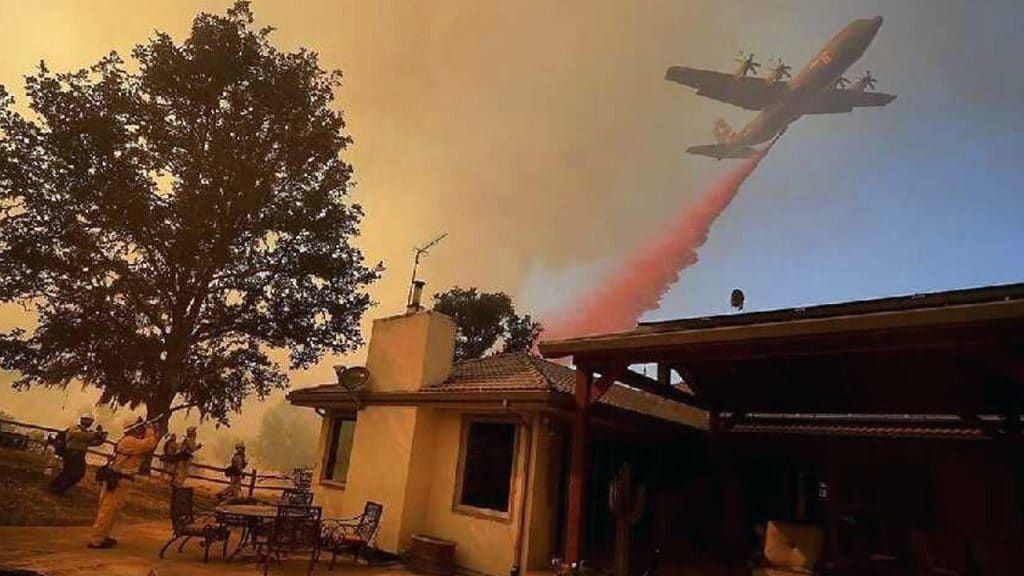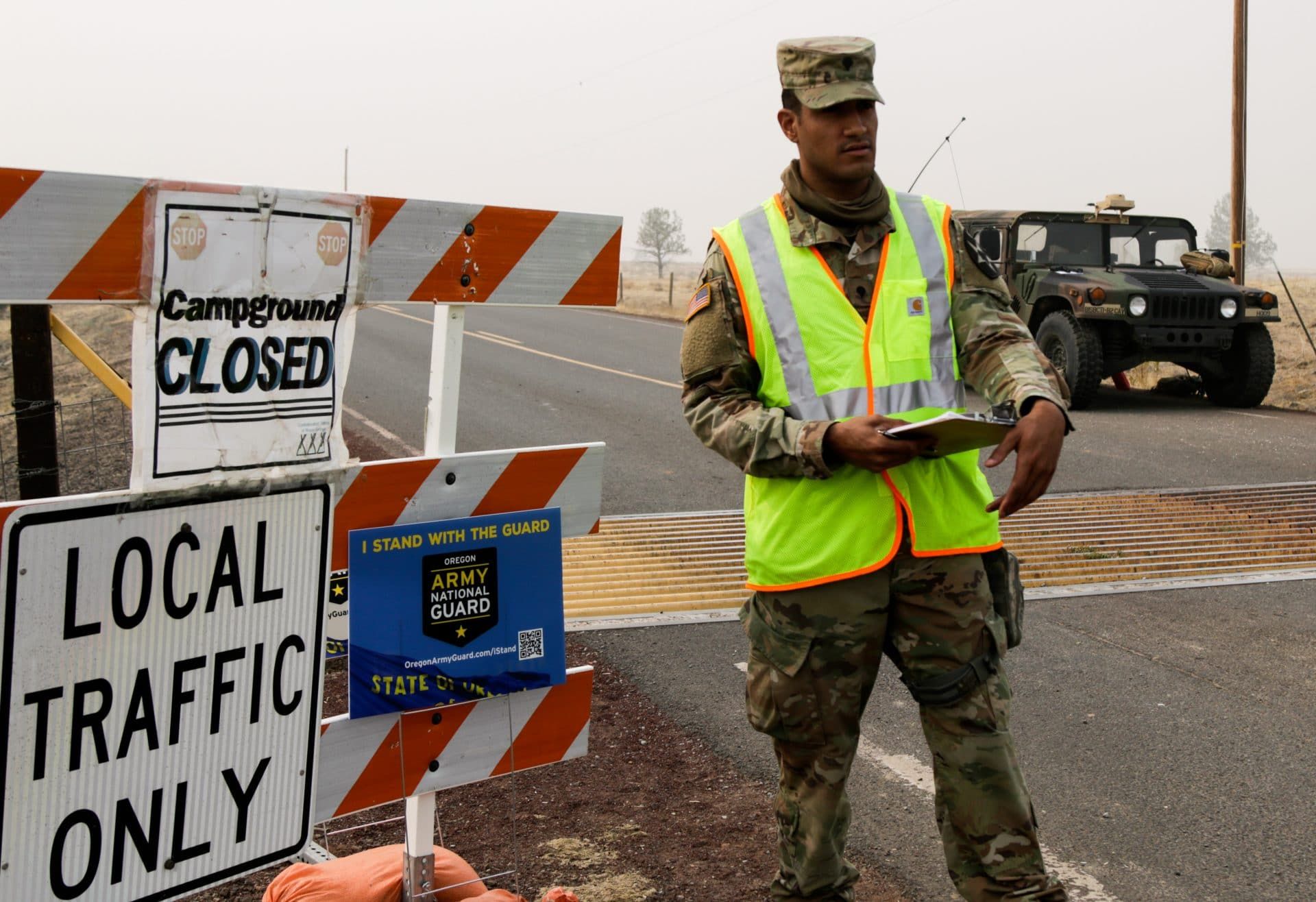Dealing with climate change requires more fight and less flight
By Dawn Stover | October 26, 2020
 A plane releases fire retardant during the Carr Fire in Shasta County, California, in early August 2018. Credit: California National Guard
A plane releases fire retardant during the Carr Fire in Shasta County, California, in early August 2018. Credit: California National Guard
At a campaign rally on October 16, President Trump spoke openly about the possibility of losing the election and how he would cope with that. “Maybe I’ll have to leave the country,” he said.
That might be more difficult than it sounds. Many foreign countries have temporarily closed their doors to visitors from the United States, which continues to report more cases of COVID-19 than any other nation.
Trump’s response to potential disaster is typical of the way many Americans think, though. We have always been a mobile country—even during the Great Depression, Americans continued their great migration West. Not many countries have a change-of-address form included as a matter of course at the bottom of credit card statements, magazine subscriptions, bank statements, and as preprinted notecards at post offices.
Now many Americans may have one more additional impetus to pull up roots: climate change. And they expect to be able to go wherever they please, even as they deny other would-be migrants—including some who are fleeing climate-driven impacts—the right to come to this country.
Migration is often the go-to solution to economic, environmental, and social problems. Wealthy Americans contemplate moving overseas, or to one of nine US states with no income tax, for financial reasons. Americans continue to flee urban areas for suburbs with better—or whiter—schools. Retirees go abroad in search of cheaper housing and health care. And many Americans are now thinking about where they could move to avoid the most devastating impacts of climate change—even as far away as New Zealand, at the opposite end of the globe.
As climate impacts worsen, experts foresee the mass migration of millions of Americans, mostly in the form of internal displacement within the United States. But running from climate change, like so many of our responses to this crisis, is at best a Band-Aid solution that delays meaningful action. Focusing on flight leaves fewer resources for “fight.” And it assumes a freedom that affluent (and sometimes not-so-affluent) Americans take for granted: migration privilege.
In search of safety. “Where can I move to be safe from climate change?” a family member asked me recently. There’s no good answer. Without major changes, up to three billion people worldwide will face climate conditions that are “nearly unlivable” by 2070. Even within the United States, there is no place that will not be significantly transformed by climate change.

America’s West is facing massive wildfires. Its coasts are being inundated by sea level rise. Its desert cities and farms are stressed by ever-increasing demands for air conditioning and water. The Southeast faces increased hurricane risks. The heartland is seeing extremes of both heat and precipitation. In relatively cool places like Alaska and northern Minnesota, temperatures are rising even faster than elsewhere, melting the tundra and turning forests into savannas.
Some people have already been forced to flee to safer—though not safe—places. Entire communities such as Newtok, Alaska, and Isle de Jean Charles, Louisiana, are relocating. But governments won’t have the resources to continue buying out everyone whose property becomes uninhabitable, and some experts are arguing for “managed retreat,” a more orderly and proactive form of relocation. Mass migration, with millions of Americans displaced, is beginning to look inevitable.
“Where can I go to be safe?” is the wrong question. The wealthiest Americans can build bunkers or buy private islands. They can pay security guards and private schools. They can access the best medical treatments the world has to offer. They can buy solar panels and Teslas. But they can no more escape climate change than they can stop breathing. They cannot purchase their own atmosphere or their own ocean.
The new climate migrants. Because many Americans do not yet recognize climate change as an emergency, some are still migrating into harm’s way. America’s coastlines and desert cities continue to swell with new arrivals and new housing developments.
That will soon change. By 20 to 40 years from now, under a high-emissions scenario with no policies to mitigate global warming, everyday temperatures in the US South and Southwest will be extremely hot, according to an analysis by ProPublica and The New York Times Magazine of Rhodium Group research. In that scenario, some counties in Arizona will be above 95 degrees for half the year, and some parts of the Midwest and Louisiana will be so humid for about 18 days of each year that humans will need air conditioning to stay cool enough for survival.
Something like a tenth of the people who live in the South and the Southwest — from South Carolina to Southern California — will decide to move north in search of better economy and environment.
Those who stay will be disproportionately poor and elderly.https://t.co/QrCnjLNZpd
— ProPublica (@propublica) October 4, 2020
These conditions can be expected to drive approximately 10 percent of the people in the South and the Southwest to move north. Those left behind will include the people least able to move—or to cope with the increasing heat and humidity—the poor and the elderly.
At the international level, it takes a certain amount of wealth (or luck) even to consider pulling up roots and relocating to another country: money for smugglers or boat transportation, for example. The most desperate don’t have that option. The same will be true for Americans hard-pressed by climate change. Almost 9 percent of American households don’t even own a car. Roughly 40 percent don’t have $400 in the bank for an emergency.
The conversation about climate migration has for many years focused on people in sub-Saharan Africa, Southeast Asia, and Latin America. But it is gradually dawning on Americans that they too may eventually become climate refugees. The Urban Institute estimates that more than a million Americans moved in 2018 alone as a result of either a climate-exacerbated natural disaster or fears of a future catastrophe.
Most of these climate migrants have gone to nearby areas that are less threatened. As more and more migrants move to these “safe” places, however, they will compete for jobs and housing with people who already live there. The welcome mat will get frayed.
Defending home. This country was founded on the idea of an endless frontier, there for the taking. But now even California is no longer the promised land.
Climate scientists have criticized some of the recent migration projections as exaggerations. Maybe conditions will never get as bad as worst-case scenarios predict. Maybe it will take longer than 40 years to get there. Maybe the global coal industry will collapse sooner than anticipated, or new government policies in the United States and elsewhere will avert the most severe impacts. But there is little doubt that, without a dramatic and rapid course correction, temperatures will continue to rise—and climate migration will rise along with it.
A few people asked me about the accuracy of a recent NY Times Magazine / NY Times Daily Podcast story “How Climate Migration Will Reshape America”. It contains plenty of interesting discussion on e.g., property insurance under a changing climate BUT…https://t.co/HYPBkCXY2j
— Patrick T. Brown (@PatrickTBrown31) October 4, 2020
Many Americans say they’d be willing to fight for their country. But for some reason, defending one’s country does not seem to extend to insisting on policies to stabilize their homeland’s climate, or calling for an end to subsidies for climate-altering activities. Instead of implementing solutions like drought-tolerant landscaping and fire-resistant roofs, many people are thinking about moving to another county, or state, or foreign country.
Where the grass looks greener. So far.
Together, we make the world safer.
The Bulletin elevates expert voices above the noise. But as an independent nonprofit organization, our operations depend on the support of readers like you. Help us continue to deliver quality journalism that holds leaders accountable. Your support of our work at any level is important. In return, we promise our coverage will be understandable, influential, vigilant, solution-oriented, and fair-minded. Together we can make a difference.
Keywords: climate migration, privilege
Topics: Climate Change, Columnists














